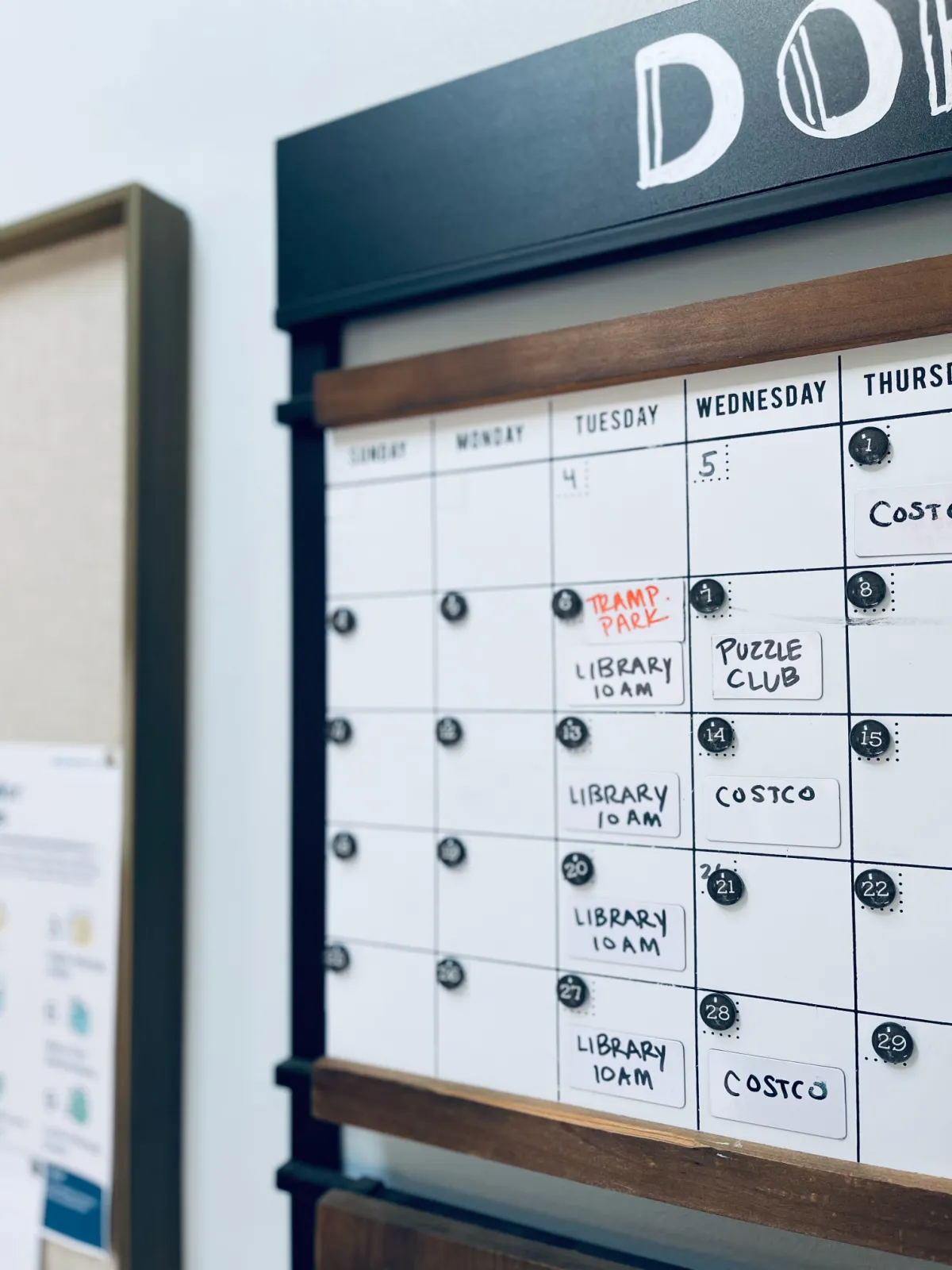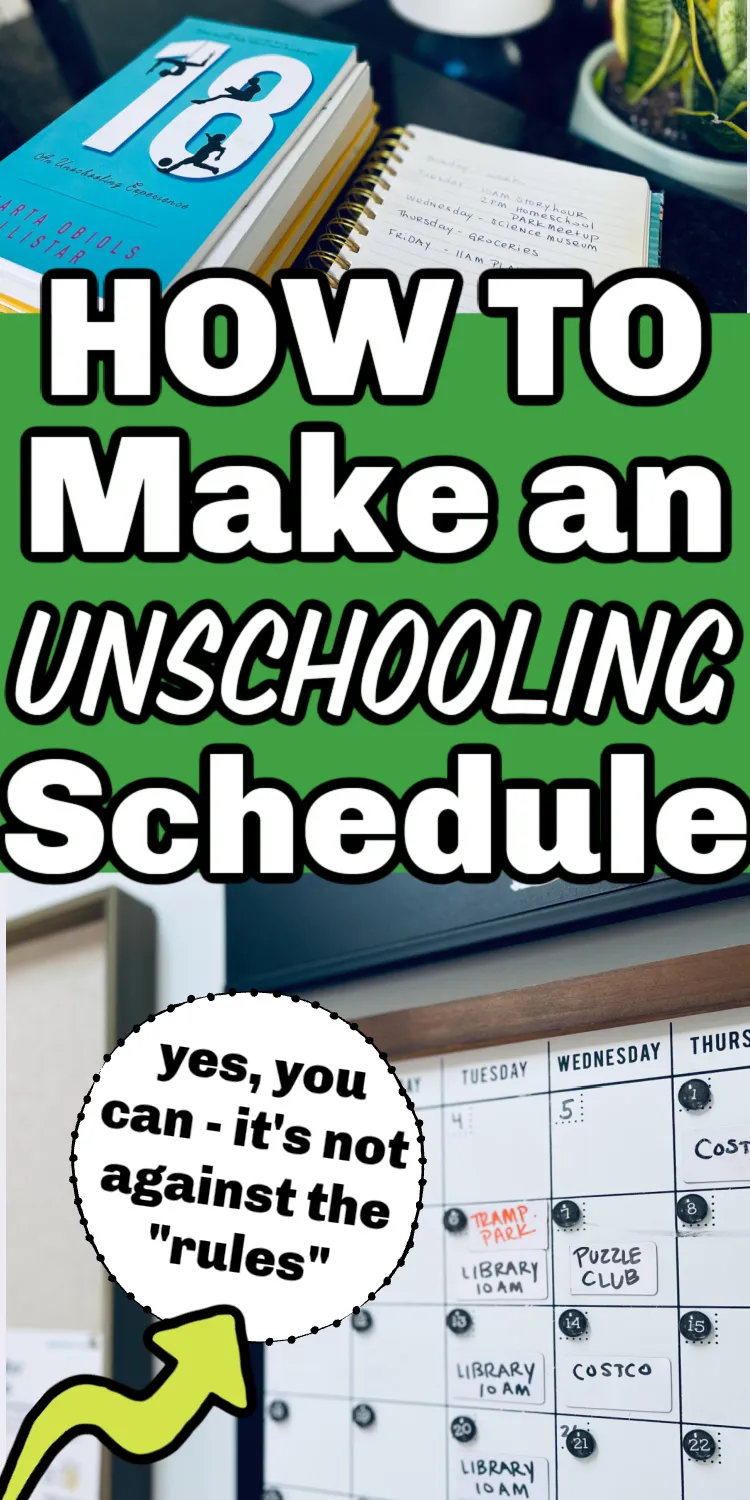Inside: Wondering how to go about creating an unschooling schedule, and if you can even do that and still be considered unschoolers? Learn how creating a schedule looks different when you unschool, and tips for creating your own in an unschooling-friendly way.
Our relaxed homeschooling (pre-unschooling) days used to run on a mini-schedule of sorts.
- Breakfast
- “Educational” show for the kids while I did my morning routine
- Morning time
- Workbook time
- Outdoor time.
Certain days were library days, and others were museum days. We participated in a Wild & Free group one day a week.
Lots of boxes to check: boxes I created because I thought I had to, because I thought that’s what a good homeschooling parent did. And when I checked those boxes, I felt SO good about our little homeschool.
This is partially why I was so hesitant to embrace unschooling. Handing over the educational reins to my children, letting them “drive”, meant letting go of my little schedule, letting go of my boxes and letting go of control.
I really liked my schedule, and I really liked control.
So when we first transitioned to unschooling a few years ago, I had to let go of schedules altogether for a while. Call it recalibrating or finding balance or whatever.
I threw my schedules right out the window along with lots of other schooly things. We had a few rhythms, and that was enough.
But recently, I realized we actually have embraced having a schedule again, if you can imagine a schedule not completely dictated by the clock. It’s consent-based, and it works for everyone in our family.
So if you’re new to unschooling and you’ve been longing for some kind of schedule to anchor your unschooly days, here are a few tips to guide you as you create your own.
(If you’re curious, you can find our former unconventional big family homeschool schedule HERE.)

How to Create a Family-Centric, Collaborative Unschooling Schedule
This post probably contains affiliate links, which means I may earn a commission if you make a purchase through those links. As an Amazon Associate, I earn from qualifying purchases. You can find our full disclosure HERE.
You CAN unschool and have a schedule. It’s not taboo. However, HOW you build your schedule does change when you choose to unschool.
In pre-unschooling life, I scheduled specific times for learning.
We would have (required) morning time for reading Story of the World and Life of Fred math together. We would have poetry tea time, nature walk time, etc.
There was nothing inherently WRONG with those activities. If your kids love chronological history, by all means, read Story of the World all the way through!
The problem was that I alone dictated the schedule, and I didn’t include my kids. I also thought learning was something I needed to schedule, something that fully depended on me. I didn’t let them opt out.
I thought I knew best what they needed to learn and when they needed to learn it. Kind of like schools do.
Our unschooling schedule today looks very different – it’s built around outings we enjoy and just living life. These outings often involve learning and inspire learning, but never do I say “during 10-12 every day, we will be learning history or math or language arts”.
A child might choose to take a class or play a sport, and that activity is then built into our schedule, but it’s not me dictating “you must take this class”. That’s their choice.
Things like reading aloud or board games or crossword puzzles, which are still a regular part of our lives are now regular, but spontaneous, dependent on everyone’s moods that day.
Projects are spontaneous depending on a child’s interests and natural rhythms.
(Because what’s the point of playing a game when nobody really wants to play? Or reading when everyone would rather be doing something else? Or trying to do a project when you’re not feeling creative?)
Finally, if you do create a schedule, remember that it should support your family and help you thrive. You’re never a slave to the schedule, and the second it stops supporting you, it’s time for change.
Here are seven helpful tips to craft your own unschooling schedule – one that serves your family.
Related: What Is Unschooling? Defining a (Very) Misunderstood Homeschool Style
1. Reflect on why you want a schedule in the first place.
When you first start unschooling, you probably feel more than a little bit unsettled. It’s pretty foreign compared to the traditional school path!
Especially if you loved the certainty of school and how it shaped your entire universe, embracing the freedom that is unschooling can feel scary.
You might want to create your own unschooling schedule because…
- It makes you feel like you’re doing that ever elusive “enough”
- You worry that your children won’t be able to stick to a schedule later on if they ever need to (jobs, college, etc.)
- You think it’s what children need to thrive
- YOU need schedules to thrive.
If those first three are why you want to create a schedule, you probably need some more deschooling (I’m convinced deschooling is a lifelong process!). Question the underlying messages behind all of those fears and mandates.
But if it’s that last one? It’s o.k. for YOU to need a schedule to thrive.
And know that you are free to create one for your own needs AND for daily events or routines where others depend on you.
You Might Also Like: Relaxed Homeschooling Versus Unschooling – What’s the Difference?
2. Create a schedule for your own needs and determine personal boundaries for when your children’s needs overlap with your own.
If you’re unschooling, it’s probably not ok to dictate a schedule for the learning and lives of your entire family.
A huge part of unschooling is consent, so, for example, if none of your unschooled kiddos want to go to co-op every week but you’ve been pushing it, it’s probably time to consider dropping it.
That being said, you are NOT a doormat. You don’t exist only to serve the needs of your children, even if a big part of your role right now is to facilitate homeschooling.
With things like meals and chores and bedtimes, your needs matter just as much as theirs, if not a little more simply because if you burn out, the whole system falls apart.
I decided a long time ago that I couldn’t continue to unschool if I burned out.
So I abandoned the radical unschooling dogma that seems exclusively child-centered to me and VERY caregiver heavy, and I decided we would create an atmosphere where every family member’s needs were considered equally.
My kids do a small chore daily or weekly in order to share the daily cleaning load because I can’t do all the household tasks and have energy left to facilitate unschooling.
Bedtimes are pretty flexible as children get older, but I’m only available until a certain time every night to meet children’s needs. After that, I can’t make sandwiches, read books or help children in any way unless they’re ill – I’m going to bed at X time.
One day a week, I go out to work, and Dad’s on duty. Another day is my cleaning day, so I spend a couple hours cleaning so that I don’t need to later that week and can give kids the majority of my attention.
For a while, I could only handle an outing every other day. I desperately needed my at-home days.
Now that my youngest is almost five, I have a much greater tolerance for being out of the house. Therefore, my children’s options have expanded as I can handle the busier schedule.
If you need to make dinner before 6:00 because you know you won’t make it at all if you wait until later than that, put “start making dinner” on your schedule for 5:30.
So start with you. What do you need? What are your “big rocks” that will keep you and your home running smoothly that need to be put on the schedule first?
3. Consider the ages and temperaments of your family.
When your children are small? You mostly steer the ship with the “5 and under” crowd.
So if you want to play a board game after lunch every day, and that helps you fit something everyone enjoys into your day, great!
If there’s a park meet-up once a week with a local homeschool group that everyone enjoys, awesome. Put it on the schedule.
But keep in mind that even at young ages, children start to show you who they are, especially if they have a different temperament than you do.
Certain children want to be out of the house all day every day. Others leave the house once a week, and they’re wiped out, happy to stay home the other days.
You need to find a balance between your children’s needs and your own.
If your child melts down when you try to add things to the schedule more than once or twice a week (even though you love leaving the house), there might be a season where you need to stay home more than you’d like.
Or maybe you need to hire a babysitter once a week so YOU can have a day on the schedule that’s yours alone.
And vice versa: if your child wants to leave the house more than you do, maybe your partner takes a shift on the weekends so you can stay home. Or you find a grandparent who can. Or you swap playdates with a friend.
The tricky part is when you have older kids with various temperaments and needs.
For instance, if everyone except one child loves the weekly homeschool co-op, but they are too young to stay home alone, could they come along but bring books to read or other things to do, instead?
Family is about balancing everyone’s needs and trying to find the best solution for everyone.
The one phrase we still use regularly from Love and Logic is, “You can come and have fun or come and not have fun – your choice.” Because sometimes that’s the only choice you have.
Compromise always and validate the challenge of doing things you don’t want to do, and continue to think creatively about how to find balance with mix-matched temperaments and needs.
For instance, if child A hates co-op but everyone else loves it, maybe everyone else commits to an at-home day the day after co-op because child A adores being home.
4. Ask for – and give equal weight to – your children’s ideas and desires as you create your family schedule.
As your children get older, and they can voice their desires and needs more clearly, take them into account as you create your schedule.
Obviously, you can’t do everything. There are money constraints and big family constraints and health constraints.
But most of the time, you can meet the majority of their needs and wants, if creatively.
If one child wants to go to museums more, create a museum day. Or if your outings need to be more limited, choose a regular outing day (library, nature walks, etc.), with museums as part of the rotation.
Start with the bigger scheduling needs like grocery day or homeschool co-op day or outschool class day. Then consider what can be added to the “must-do’s”.
Maybe one child wants to play board games regularly. So if you want to put that on the schedule, consider what part of the day would make it happen consistently.
Maybe before you make dinner every day is board game time? Or immediately after dinner? Could you push kitchen clean-up until after board games to make it happen?
Also take into account their dislikes.
If everyone hates co-op, then why are you still holding onto it? If everyone reluctantly drags their feet to “board game time” on the family schedule, it might be time to let it go.
5. Add daily downtime to your schedule.
In our household budget we have a pretty significant “buffer” category. It’s a few hundred dollars a month to handle random unexpected house purchases or kid expenses.
And most months, we use it.
Make sure to schedule in large chunks of downtime where everyone is doing their own thing, and you’re free to step in and help when needed.
That time could be “project time” like Sara from Happiness Is Here.
Or it could be everyone having roomtime and pursuing their own interests. Or it could be outside time.
But ultimately, downtime is open for the needs and whims of the individual.
Remember: the heart of unschooling is self-directed learning. As your kids grow, they will need increasingly more space and time to explore their own interests.
They might still love read-aloud time, board games or museums, but they truly need time to pursue their own ever-evolving interests.
6. Reevaluate your schedule seasonally.
It probably goes without saying that what worked six months ago might not work today.
Interests change. Children change (all.the.time!). Families grow. Parents change jobs. Activities start and stop. Kids start driving and working and all.the.things.
“The only constant in life is change.”
-Heraclitus
When a schedule starts to feel forced for most of the family, it’s time to reevaluate.
Or you might need to reevaluate every 2-3 months, before or after sports seasons or when any major life event happens (new baby, a move, etc.). Or biannually.
Only you can know the best time for your family to reevaluate the schedule. Just know they do need to be reevaluated regularly.
7. Let go of the idea that a schedule needs to stick to the clock to be a schedule, and above all, stay flexible.
Obviously if parts of your schedule are connected to “the outside world” (ha!), you’ll need to stick to the clock as best you can.
As I’ve explained to my 5-year-old, library story hour starts at 10:00 a.m., so if we’re late, we’ll miss parts of it. Next year, we are considering a co-op where classes start at set times, and in the future, I will likely have children taking online classes that start at set times.
We also talk about sticking to parts of our schedule where other people are counting on us to be there.
I constantly see new-to-homeschooling parents complain that they went to a meet-up, but no one showed up, despite many families “committing” online.
That’s a major bummer for those families hoping to make connections, and when we are too individualistic with our schedules, it does others a disservice. Having been on the receiving end of others not fulfilling commitments has strengthened our resolve to show up when we say we will.
Rugged homeschool individualism and NOT wanting to be bound by schedules/commitments has its downsides.
But for the parts of your schedule that only affects your own family, try to stay flexible!
If you start board games twenty minutes later than you wanted, it’s o.k. to push dinner back twenty minutes or play one less board game than usual that day.
Rigidity will quickly kill any schedule you try to create. Your children will get frustrated, and you’ll get frustrated (ask me how I know).
Flexibility is essential if you want to homeschool for the long haul.

Bottom Line: You Can Have an Unschooling Schedule If You Want To
You are free to follow the best path for your family, yourself and your children. Don’t let unschooling dogma or perceived unschooling rules hold you back.
As long as you are respecting your children, centering your family on consent as best you can and working to meet everyone’s needs as much as possible, you’re good!
Be free to do what works best for your family. Listen to your intuition and follow it.
If you believe that your family will thrive with a more structured schedule, then create one. You’ll never know if you don’t try.
You might find it’s exactly what you were missing. And even if you don’t, that’s ok, too.
We’re all out here taking it one day at a time, figuring out how to create the best unschooling life for our unique family.
Some of us will thrive with schedules, and others won’t.
The point is we’re not bound by the schedules of school, and we’re free to figure out what works best for our own families. And that, my friend, is the beauty of unschooling.
Read Next: The Pros and Cons of Unschooling – Some Brutal Honesty


